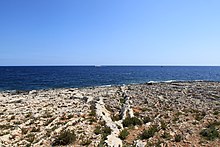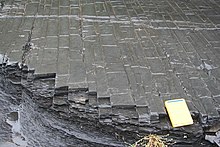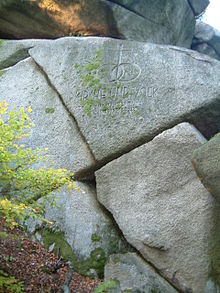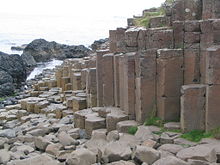Joint (geology)
Fractures or fissure surfaces, also known as lies in mining terms, are separating surfaces in the rock that are created either by tectonic stress or by non-tectonic causes. Non-tectonic causes of fractures are pressure relief (especially in plutonites), pressure loading (e.g. by sediment supply or meteorite impact), diagenetic processes or cooling (contraction) of rocks.
The opening of a fissure, i.e. the space between the two walls, is in the range of less than a millimetre in width up to an extension of several metres. In the microscopic range, one speaks of microcracks. Larger fissures that extend over a longer distance are called main fissures.
The directional frequency of fractures can be represented graphically in the so-called fracture rose. Different, almost parallel fractures are called fracture couloirs. Fissure couloirs are an important object of investigation in structural geology and geophysics. The direction of fracture fractures usually corresponds to the axis of compressional stress in a region, and in tectonically active areas their orientation often corresponds to the focal planes of earthquakes.
Fissures and fissure clusters of different orientation but with a common history of formation form a fissure system. Regardless of their origin, all fissures occurring in a given area are called a fissure network.
As a rule, no offset of the separated rocks takes place at the fissure surfaces. However, if major movements occur along the fissures, they develop into faults. When fissures open laterally, fissures rupture.
Geophysicist Adrian Scheidegger (Switzerland and Vienna) is considered an important expert on fissure tectonics. His research on the geomorphology of alpine landscapes and on the statistics and dynamics of regional fractures gives strong indications of how the main axes of geological stress and directions of movement lie within continental blocks. Where local fracture directions do not coincide with continental directions, they often correspond to older tectonic phases (e.g. Variscan), which can thus be traced long after they have subsided. For example, the Diendorf fault north of the Wachau (Lower Austria) shows a clear connection with a foliation shift of the Danube, whose valley was displaced by about 30 km to the northeast.
When a fracture opens, fracture minerals can be deposited along the fracture surfaces by the circulation of groundwater or hydrothermal water. Characteristic mineralization is formed by quartz, which occurs in different varieties, as well as other silicates such as epidote or chlorite, various carbonates, and some ore minerals. In water-soluble rocks, such as limestone, gypsum and some calcareous sandstones, fissures can widen as a result of progressive dissolution of the surrounding rock, thus leading to the formation of karst caves.
Larger fissures filled with rock and minerals are called veins or, in the case of elevated ore metal content, ore veins. If the fissure filling is more weather-resistant than the surrounding rock, fissure networks can weather out as positive ledges.
On the Moon, fissures can reach larger dimensions because they do not close by erosion or tectonics. They are signs of fossil stresses in the lunar crust and are divided by astronomers into the form groups of rupes (terrain steps) and rimae (grooves).

Positive weathered fracture network in Malta

Right-angle fracturing in siltstone and black shale in the Ordovician Utica Shale near Fort Plain, New York State, USA.

Orthogonal fissure system in the Kösseine granite

Columnar fissure in the basalts of the Giant's Causeway in Ireland, formed by thermal contraction
See also
- Fault (geology)
- Corridor (geology)
- Column (Geology)
- Separation surface (geology)
Search within the encyclopedia